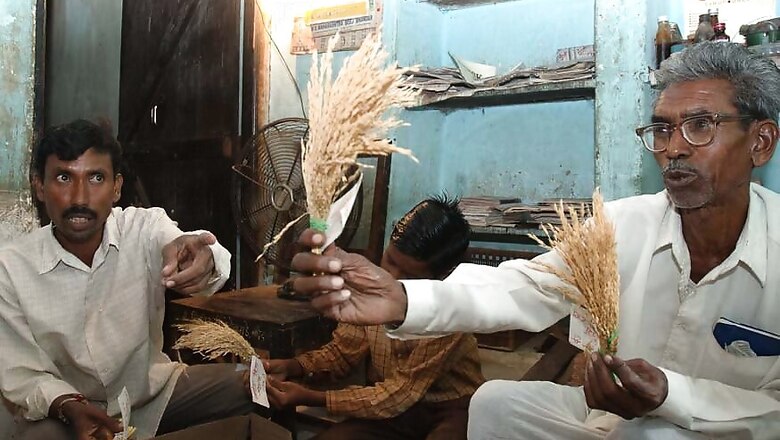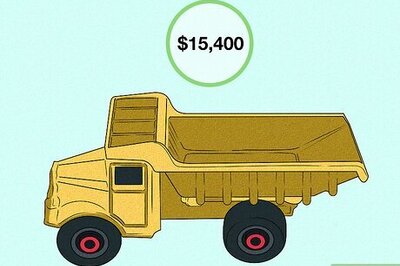
views
Nagpur: He fought for his rights but could never quite get his due.
Dadaji Ramaji Khobragade, the inventor of HMT-Sona and ten other popular rice varieties died on Sunday at the Search hospital in Gadchiroli. The Dalit farmer, who won global acclaim for his innovations, had suffered a crippling paralytic attack a month ago.
He is survived by his son, daughter-in-law, and grandchildren.
The 80-year-old had been unwell for the past six months. He was frail and his listening capabilities were hampered.
For his work and farm innovations, Dadaji earned a lot of goodwill and support from many quarters including institutions and individuals. This was something that kept pushing him to work, even in his old age.
Dadaji was active until last year when he would make at least one visit to his farm every day. The veteran stopped working when his body would no longer back up his mind and his ideas.
During his childhood, he reared the village cattle and could never go to school. As an adult, he invented 11 popular rice varieties that occupy vast stretches of paddy land in central India.
HMT-Sona gives an average yield of 40–45 quintals per hectare and has short grains, high rice recovery and good aroma. The variety is now marketed in Andhra Pradesh, Gujarat, Chhattisgarh, Madhya Pradesh and Maharashtra. Chinnour, Nanded-92, Nanded-Hira, Vijay-Nanded, Dipak-Ratna and the latest DRK-I and II, were some of his other finds with an average yield of about 20 quintals per acre in rain-fed conditions.
For many years, the octogenarian lived in a dingy hut in Chandrapur’s Nanded village. A few years ago, with the money from his awards and help from a few people, Dadaji built a house that also became his seed godown. Awards, medals and citations would hang by the walls in a room.
He first shot to fame when he accused the state-run Punjabrao Krishi Vidyapeeth (PKV) for taking credit for the brand that he had originally bred on his farm and given to the university scientists. This was in early 2000s.
While Dadaji claimed the PKV had appropriated his variety, the PKV held that sourced it from him and significantly improved the variety with their scientific inputs. The issue remains unresolved till date. PKV never officially gave Dadaji his credit in its varietal release proposal.
The National Innovation Foundation (NIF) recognised his work in 2003-04 and the Maharashtra government gave him the Krishi Bhushan and Krishi Ratna awards for his innovations. One of his varieties called Chinnour is akin to the Basmati of the north. He named his latest variety after himself: DRK.
In 2010, Dadaji’s name figured in the Forbes list of top seven Indian rural entrepreneurs, after it was picked up by the IIM-Ahmadabad professor and founder of the Honey Bee Network Anil Gupta. Dadaji could not make any sense of what it meant. “I am happy, but I don’t know what it means to me and to my fellow farmers,” he said.
When I first met Dadaji in August 2005, he recounted to me a number of heists that took place on his farm every day. Someone stole pumpkins one day; the other day, it would be a wooden cot that he kept for himself. In summers, people stole wild berries and even rice.
He wasn’t bothered about those thefts as much as he was about the fact that the PKV never quite officially acknowledged the HMT-Sona as his discovery. Even the name was given by Dadaji when he went to the market in Mul town, back in early 1990, and a trader asked him to suggest a name for the rice variety.
“I’d wear an HMT-Sona watch on my wrist,” Dadaji recounted in my first interview. “I looked at it and told the trader ‘let it be named HMT-Sona’.” It took the consumers by a storm for its fragrance and taste.
In 1983, Dadaji noticed three yellow-coloured strains of paddy corns in his farm. “They were different," he told me. The innovator preserved them and sowed them again on his farm the following year. The rice it yielded was soft and tasty with better oil contents. He repeated the process over seven years with the selection method. A decade later, it became a hit with the local farmers.
Dadaji had bred this particular variety from the Patel-3 variety that he would plant on his fields. He had an eye for the best grain and a heart for farming. As his son Mitrajeet would once tell us: “Dadaji spoke to his paddy strains as if they were his kids, softly and lovingly.”
He was uneducated, but he was deeply inspired by Dr Babasaheb Ambedkar. Dadaji was a Mahar by caste and an Ambedkarite by political belief. “I stopped skinning the cattle on the call of Dr Ambedkar,” he once told me. “I never got to see Babasaheb, but my generation came out of our past shadows because of him.”
During one of our interactions at his home, Dadaji told me how he was landless once. “This present land is my daughter-in-law’s land. One-and-a-half acres, it came to her as property from her side.” That land had dual purposes — it was his family’s sustenance and his lab.
“No one told ever me how to breed the varieties; I kept doing it out of my love for the best grains.”
Like a true parent breeder, he could separate the real from the fake. “This is not my rice,” he once told me of a variety I had taken to him. A Nagpur grocer sold it as HMT-Sona. Dadaji said it wasn’t.
He gave me a few kgs of the original, the rice he had found on his farm and bettered it. It tasted much better and was qualitatively different from the one I had bought from a shop in my home city.
Dadaji once tried experimenting with paddy and turmeric as an inter-cropping system on his farm. He succeeded with the yields but held commodity prices were a key factor. “Farmers will remain poor unless they get remunerative prices and capital to start allied activities,” he told me.
In 2006, Dadaji took on the Vilasrao Deshmukh-government for having gifted him with a fake gold medal. Dadaji discovered that a 14-carat gold medal that he got from the government as part of the Krishi-Bhushan award package was actually made of sub-standard silver whose value was no more than Rs 500. “I am shocked,” an agitated Dadaji said then. “Why insult us like this?”
Dadaji was presented a 50 gram 14-carat gold medal, cash prize of Rs 25,000 and a citation from the Maharashtra Governor for his achievement. “I used all my cash awards to buy some land for research work.” When he wanted to sell the gold medal to buy a motor-pump, he was told the medal was actually a dud.
Dadaji returned his award in anger, prompting other medallists to return their awards and the state government to launch an inquiry and apologise to the farmers by reinstating their awards with original gold medals. Dadaji favoured the intellectual property rights to be bestowed upon farmers like him.
Seed savers like him were crucial to food security and seed diversity, he once told me at his home. “Farmers must not merely complain of the problems,” he held. “They should also try to be a solution.”
(The author is a Nagpur-based journalist and a volunteer for the People’s Archive of Rural India. Views are personal)




















Comments
0 comment